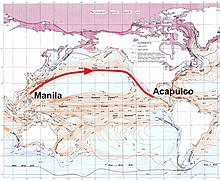Manila galleon
|
Galeón Andalucía during her stay in Puerto de Huelva, February 14, 2010
|
||||||||||
|
||||||||||
|
||||||||||
|
||||||||||
A Manila galleon (Spanish: Galeón de Manila ) is the name given to a Spanish ship which, at the time of the Spanish colonial empire , handled goods traffic between Manila , the capital of the Philippines , administered as a subcolony from New Spain , and Acapulco .
Term and type
The name does not refer to a special type of galleon , but to the port of departure, Manila, from where the ships loaded with goods from the Far East (e.g. precious stones, spices, porcelain, silk) usually set off once a year for Acapulco, where they in turn made silver took on board and brought back to purchase the Far Eastern goods. The term galleon was also used when this type of ship with its building tradition was no longer built in Spain.
The trade route
Although ships regularly sailed from the Philippines to New Spain as early as 1565, shipping on the Manila-Acapulco route did not begin until after the conquest of Manila by Miguel López de Legazpi in 1570. An important stop on the route were the Mariana Islands, annexed in 1565 . For this purpose, a garrison of around 20 Spanish officers and non-commissioned officers, 110 Filipino troops, and a militia of the local population of around 460 men were maintained on the island of Guam . The cost of this garrison in the amount of 20,000 Pesos was financed as an annual real situado from the customs revenue of the Manila galleon collected in Acapulco.
The scope of trade was strictly limited by the Spanish crown. The annual volume of trade was limited to 300 tons in 1595 and 500 tons in 1702. One or two galleons could cover this trading volume. The dissolution of the Viceroyalty of New Spain in connection with the independence of Mexico in 1821 also meant the final end of the Manila-Acapulco route. Of the 108 galleons that made the voyage several times over the course of 250 years (1565 to 1815), 30 were lost, only 4 of them were conquered by privateers.
Hunger and disease, especially scurvy , which the Spaniards called the "Dutch disease", regularly bothered the crews of the Manila galleons on the long journey, which lasted at least two months.
In the 1630s, 105 crew members on two galleons were thrown overboard by the crew so that the others could avoid starvation. In 1657 the Manila galleon San José was discovered on the coast near Acapulco; on board were the corpses of those who had starved or died of thirst. A lot of silk was found in the hold that was to be shipped from Asia to America. If the galleons did not reach Manila with their silver cargoes, the merchants there could not trade with the Chinese, as they had nothing of interest to offer them apart from the precious metal. If the galleons were shipwrecked on the return voyage, the goods for which the Spanish had paid silver in America could not reach Acapulco. Trade in Manila, the intersection of the Chinese and Spanish trade networks, was completely paralyzed when three galleons sank or ran aground in 1638 and 1639, including the Nuestra Señora de la Concepción .
Modern replica
A modified replica is the Galeón Andalucía . Her maiden voyage took her to the 2010 World Exhibition in Shanghai and then to Manila. The route and the current location will be published on the Internet.
See also
literature
- Jean-Paul Desroches, Gabriel Casal, Franck Goddio (eds.): Die Schätze der San Diego (= publications of the Museum für Völkerkunde, Berlin. NF 64). Argon, Berlin 1997, ISBN 3-87024-380-5 .
- Shirley Fish: The Manila-Acapulco Galleons. The Treasure Ships of the Pacific. With an Annotated List of the Transpacific Galleons 1565-1815 . AuthorHouse UK Ltd., Central Milton Keynes 2011, ISBN 978-1-4567-7542-1 .
- William L. Schurz: The Manila galleon (= Dutton Everyman Paperback. 35, ZDB -ID 2420797-4 ). Dutton, New York NY 1959.
Web links
- Edward Von der Porten: Chinese porcelain from wrecks of early Manila galleons. (PDF file; 608 kB) In: Skyllis - Zeitschrift für Unterwasserarchäologie, 4th year, issue 2 2001, pp. 166–172.
- Travel dates and last position report of the Galeón Andalucía
- Video of the Galeón Andalucía trip to Asia
Individual evidence
- ^ Gerd Hardach : King Kopra: The Marianas under German rule 1899-1914 . Steiner , Stuttgart 1990, ISBN 978-3-515-05762-2 , pp. 20-26 .
- ↑ Eberhard Schmitt, Piet C. Emmer, Manfred Mimler, Anneli Partenheimer-Bein: Economy and trade of the colonial empires (= documents on the history of European expansion. Vol. 4). Beck, Munich 1988, ISBN 3-406-30661-6 , p. 666.
- ^ Tom Bennett: Shipwrecks of the Philippines. ( Memento from November 15, 2013 in the Internet Archive )
- ↑ Timothy Brook: Vermeer's Hat. The 17th century and the beginning of the global world. Edition Tiamat, Berlin 2009, ISBN 978-3-89320-133-4 , p. 185.
- ↑ Timothy Brook: Vermeer's Hat. The 17th century and the beginning of the global world. Edition Tiamat, Berlin 2009, ISBN 978-3-89320-133-4 , pp. 190-191.


